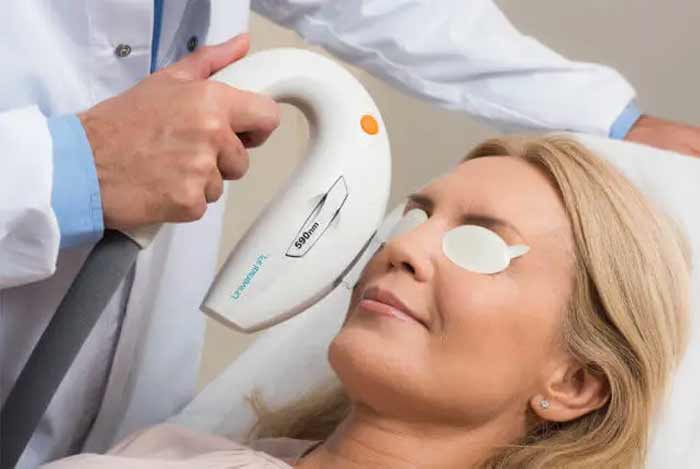 |
| The addition of a heated eye mask to IPL therapy may improve patients’ symptoms through improved blood circulation and symptomatic relief of ocular fatigue. Photo: Lumenis. Click images to enlarge. |
Tear film lipid layer deficiency ultimately leads to worse evaporation of tears in dry eye cases, prompting eye doctors to direct considerable attention to remedying meibomian gland dysfunction. Consequently, researchers of one new study wanted to investigate the effectiveness of combined therapies of intense pulsed light (IPL) and using a heated eye mask, both of which have demonstrated previously to improve the tear film lipid layer as well as signs and symptoms of dry eye disease.
The study included three different groups: (1) a combined IPL and heat mask group, (2) another using only IPL and (3) a control group of untreated subjects with evaporative dry eye. All participants were examined at baseline, day 21, day 42 and day 84 for noninvasive tear breakup time, TFLL, corneal conjunctival staining, meibomian gland quality and expressibility and OSDI scores.
Researchers found on the last day (day 84), significant improvements were noted in lipid layer integrity, noninvasive tear breakup time, corneal conjunctival staining, meibomian gland quality and expressibility and OSDI scores of the combined therapy and IPL groups. The control group saw no significant improvements. What’s more, change in lipid layer scores correlated with change in all other parameters.
These findings are supported by the fact that the lipid layer “not only supports the tear film homeostasis, but reports suggest that meibum possesses antibacterial properties that maintain the health of the lid margin,” which can enhance lipid quality, the authors wrote in their paper.
They continue by explaining that some research hypothesizes heat energy from IPL liquefies blocked meibomian glands with meibomian gland dysfunction, thus reducing gland blockage and stimulating meibum release, but this has not been seen with standard IPL devices, which pulse light around the eyelid periorbital region. Instead, this study’s use of adding a heat mask in combination with IPL has allowed for successful liquefaction of meibum, thus improving lipid layer status of participants in the combination group, the authors conclude.
Further elaborated is the rationale behind combination of IPL with heat mask, which is based upon the functions of each procedure. A heated eye mask has been outlined in the TFOS Dry Eye Workshop to reach a therapeutic level of heat that can liquefy meibum as a “Step One” noninvasive method to manage dry eye. “Step Two” would be the use of the more potent IPL, which improves meibomian gland function through blood vessel ablation, meibum fluidification and reducing inflammatory cytokines.
Efficacy of nonpharmacological therapies, including thermal pulsation and IPL have shown efficacy in improving evaporative dry eye for a prolonged duration, even in as little as one or two sessions.
Because of this observation, the authors posit that “with further robust clinical trials, nonpharmacological therapies have the potential to facilitate healthcare professionals in providing appropriate counseling and therapeutic interventions with less dependence on prolonged pharmacological interventions.”
Li L, Chen J, Qin G, et al. Tear film lipid layer changes following combined effect of heated eye mask with intense pulsed light therapy for evaporative dry eye: a randomized control study. Photobiomodul Photomed Laser Surg. 2023;41(8)435-44. |

